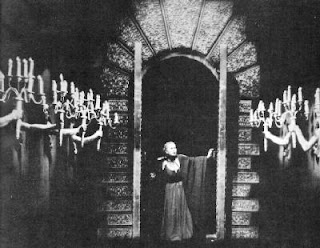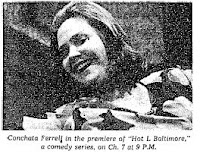(TV) (1985-1989)
Executive Producer: Philip De Guere
Episode Guide
In 1985, for no logical reason, the networks decided that anthology series were ready to make a comeback. At the time (and today) conventional wisdom was that people weren't interested in anthologies: they much preferred a series with recurring characters instead of being introduced to a new cast every week. An anthology was also dependent on good writing: if you like the characters, you might come back after a weak episode, but if the characters are new, then there's a good chance you won't. The last successful network anthology series was Love, American Style (it still is), and that had gone off the year a decade before.
There was a reason, of course, if not a logical one: Steven Spielberg. He had signed a contract to do Amazing Stories on NBC, and given an unprecedented order of two full seasons worth of shows. And network executives are nothing but bandwagon followers: if Steve is getting an anthology series, we should do our own. NBC added a revamped Alfred Hitchcock Presents, taking stories from the original series and coming up with new versions of them, with Alfred's original (colorized) introductions. CBS added George Burns Comedy World, which had George introducing short comedy episodes. And CBS also went to the well to bring up an old name: The New Twilight Zone.
Amazing Stories was really "Amazing story ideas." Too many of the stories were just an introduction of a concept, with flashy special effects (it had a great opening credit sequence, though). Alfred Hitchcock was probably a bad idea to begin with, since those who liked the originals weren't interested in updated versions, and those who didn't know the originals didn't care who Hitchcock was. Comedy World was funny, but completely ignored.
The New Twilight Zone, however, was a classic.
First of all, they did it right. Instead of commissioning all original stories (like Amazing Stories or George Burns) or doing remakes of classics (like Hitchcock), they had a mix: some new, some adaptations of originals, and some adaptations of science fiction short stories by major authors. These included Harlan Ellision, Robert Silverberg, Rockne S. O'Bannon, Joe Haldeman, George R. R. Martin, Greg Bear, Ray Bradbury, Theodore Sturgeon, and Arthur C. Clarke, among others. Wes Craven, Peter Medak, Martha Coolidge, and Robert Downey (Sr.) directed episodes. Actors appearing included Bruce Willis, Richard Mulligan, Elliot Gould, Danny Kaye, Robert Klein, Annie Potts, James Whitmore, Jr., Robert Morse, Fritz Weaver, Shelly Duval, Richard Libertini, George Wendt -- in other words, a long list of well known names.
And the show allowed for free-form episodes: it ran an hour, but the stories could run from five minutes to 45. This helped avoided padding out episodes to fill the time needed, or cutting parts from the story in order to make it fit. They even hired the Grateful Dead to do the theme music.
Some of the more memorable episodes included:
- Nightcrawlers. Directed by William (The French Connection) Friedkin, this was a tense tale about a Vietnam veteran with more then the usual type of nightmares. The format of the series served this well: it was originally shown without a commercial break within it, so the suspense kept building from start to finish.
- To See the Invisible Man. From Robert Silverberg, this is about a society where people are punished by being made "invisible": no one will acknowledge their presence. The ending is one of the most emotionally rich scenes ever to be on TV.
- Wordplay. The first script by Rockne S. O'Bannon (Farscape), this stars Robert Klein as a man who discovers that the people around him start using different meanings for words. "What do you want to eat for dinosaur?" for instance.
- I of Newton. Fun "deal with the devil story" written by Joe Haldeman.
- Gramma. Story by Stephen King, teleplay by Harlan Ellison
- Shatterday. A Harlan Ellison story about a man (Bruce Willis) who finds a double is taking over his life.
- Night of the Meek. A nice remake of the original TZ episode, with Richard Mulligan in the Art Carney role.
- Monsters. A nice twist on the vampire legend, where a vampire moves next door to a young boy, who learns what the real monsters are.
- A Matter of Minutes. An adaptation of Theodore Sturgeon's "Yesterday was Monday" with a script by O'Bannon, and starring Alan Arkin as a man who finds a bunch of mysterious blue workmen tearing down things in his neighborhood.
And that's just the first season alone. I could go on and list much more (it's hard not to); just check out the episode guide to see everything.
The show ran into a bit of controversy over a Harlan Ellison episode that the censors wouldn't allow (Ellison and controversy? How is that possible?). But the ratings were weak. The show was renewed, though they got away from the multiple story concept and began to fit them into TV-specific rates. The ratings continued to drop, but, for contractual reasons, CBS has promise a third season, there was one -- with a new writing team lead by J. Michael Straczynski. The show was on a lower budget, but still managed to put out some excellent episodes, including a dramatization of Tom Godwin's classic SF story, "The Cold Equations" and the delightful "Cat and Mouse" (there I go listing again).
Of course, once off the air, the show was quickly forgotten. The original overshadowed the remake (though I would argue the 1985 version was as good if not better), and the recent 2002 version is probably what people remember if the title "New Twilight Zone" is mentioned. But DVDs of the 1985 series do exist, and are a real treat for TV fans.







 Alfred Hitchcock is one of my favorite film directors. It's hard to say that any of his films are actuallyforgotten (other than Bon Voyage and Adventure Malgache, two short films that only recently became available), or even overlooked, but one particular gem that seems to take the back seat inSaboteur.
Alfred Hitchcock is one of my favorite film directors. It's hard to say that any of his films are actuallyforgotten (other than Bon Voyage and Adventure Malgache, two short films that only recently became available), or even overlooked, but one particular gem that seems to take the back seat inSaboteur.  The film has some great setpieces. I especially liked the way Kane freed himself from handcuffs -- and the logical result of how he did it. There was also a nice suspenseful scene at a party when Kane tries to tell the guests that Tobin is a spy. There's Kane and Pat being picked up by a circus train. The saboteur's look when he passes the wreck of the Normanidie. And, of course, the final sequence at the Statue of Liberty (a dress rehearsal for the Mt. Rushmore scene in North by Northwest).
The film has some great setpieces. I especially liked the way Kane freed himself from handcuffs -- and the logical result of how he did it. There was also a nice suspenseful scene at a party when Kane tries to tell the guests that Tobin is a spy. There's Kane and Pat being picked up by a circus train. The saboteur's look when he passes the wreck of the Normanidie. And, of course, the final sequence at the Statue of Liberty (a dress rehearsal for the Mt. Rushmore scene in North by Northwest).